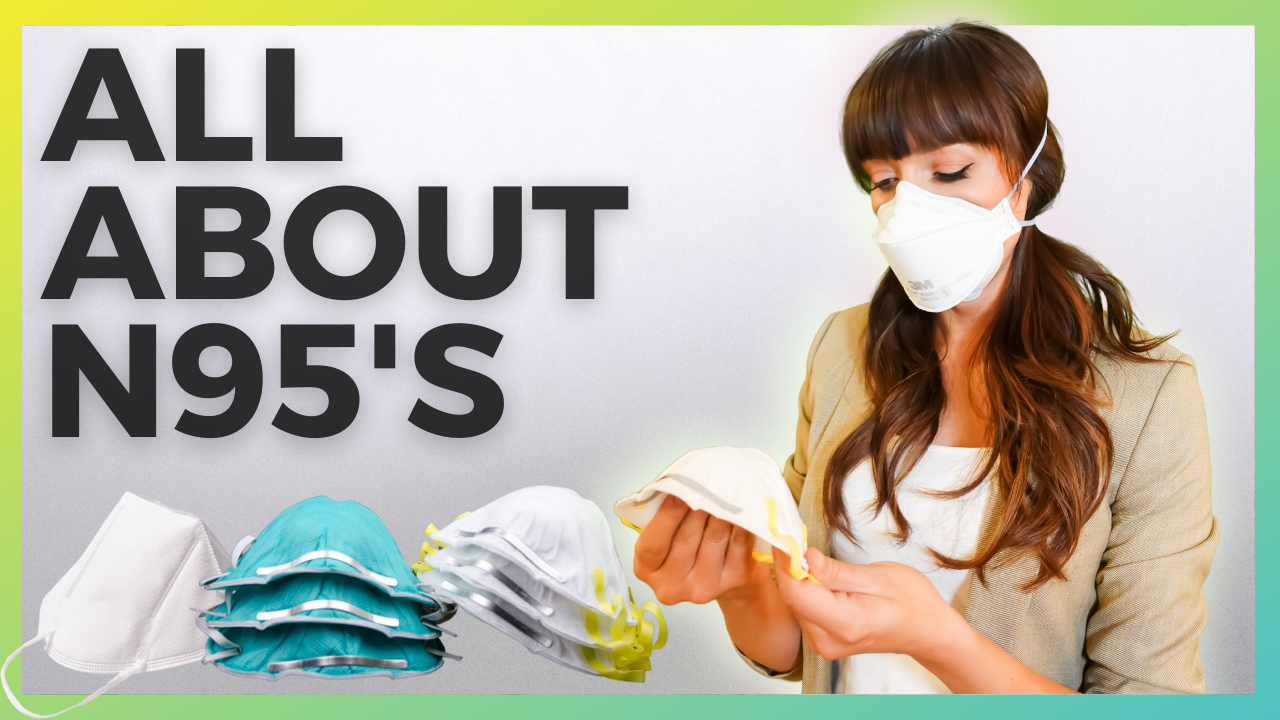In a recent survey of 5,000 Americans, 100 from each state, it was found that 83% of Americans now report wearing face masks on a daily basis.
As more and more of us start to depend on face masks to help protect our health, it's crucial that we understand the basic differences in face mask types and have a knowledge of how to check for NIOSH and FDA approval when it applies.
The purpose of this article is to give you a quick and easy guide so that you have the information you need to make the best choice on the face mask for you.
Mask Protection Levels
The first step in choosing the best face mask is understanding the different levels of protection and the different types.
So, today we're going to be focusing on the five most common types that you see out and about:

N95 Respirators
These are examples of N95 respirators.
One thing that's important to note with this section is that there's actually quite a few different styles of N95 respirators. Some are molded, some are folded and others are vented.
Intended Use
The first N95s were introduced in the '70s as industrial single use respirators.
Filtration
N95s work by filtering particulate through tiny pores found in the fabric. The 95 in the name N95 means it filters out at least 95% of airborne particulate and aerosols.
Seal and Fit
It's designed to provide a seal and fit closely to the face.
When N95s are used in workplace settings, they're required to be fit tested to make sure the wearer gets a good fit and seal, and can also handle the extra strain of breathing through a respirator.
There are typically a small range of sizes in each model, such as small, medium and large while some just have one, standard size.
It's also critical to note here that for men, you need to be clean-shaven in order to get the best seal.
Testing and Approvals
N95s are tested and approved by NIOSH as a respirator and must also be cleared by the FDA to be substantially resistant to fluids, which mimic blood and other bodily fluids in testing, if they're going to be used in medical settings.

To find out if an N95 is approved, the product should have the TC number in the product description online, on the box, and somewhere on the product itself. You can check that approval on the NIOSH registry.
KN95 Face Masks
Intended Use
KN95s are essentially the Chinese version of an N95 and were designed to be used in industrial and medical environments.

Filtration
Like an N95, the filter performance is supposed to be greater than or equal to 95% efficient. There are some variations in testing, but overall they have a lot of similarities in design.
Seal and Fit
Other differences between N95 respirators and KN95 masks are that KN95s often use the ear loop method, whereas N95 respirators use head straps.

Either way, the design is intended to provide a seal similar to an N95.
Testing and Approvals
KN95s are not approved by NIOSH and researchers have recently found that up to 70% of masks do not meet US standards for N95s.
Although certain styles of an N95 may look very similar to a KN95, KN95s are not approved by NIOSH, so they won't have the same level of quality assurance that you get with an N95.
Like an N95, KN95s must be properly fit and worn to get a good seal. In addition, due to reports finding that many imported KN95s are not as effective as N95s, it's best to only use KN95s outside of high-risk areas.
My favorite KN95's: https://allysafety.link/KN95
Use code ALLY10 for 10% off.
Surgical Masks
Intended Use
The surgical mask is intended to provide a barrier to prevent the wearer from transferring large droplets and aerosols that may contain viruses and bacteria to one another by covering the wearer's mouth and nose.

Filtration, Seal and Fit
Surgical masks provide a modest amount of filtration to the wearer, but they're not intended to be tight fitting or provide a seal.
Testing and Approvals
To be approved for use in medical environments, the FDA approves those surgical masks that are found to be substantially resistant to blood and other bodily fluids splashes, and some also comply with ASTM consensus standards.
Surgical masks work best when everyone wears a mask by preventing their own aerosols and droplets from escaping.
Overall, they can provide a nice balance of breathability and protection to the wearer.
Cloth Face Masks
Cloth face masks, which can vary hugely in style and the level of protection provided to the wearer.

Intended Use
The cloth face mask has a similar intended function as a surgical mask. They help to stop the spread of aerosols and droplets at the source, while providing some protection to the wearer.
Filtration
Filtering depends on the amount of layering and the the fabric weave of the materials used.
Recent research from MIT has suggested that multiple layers of high thread count cotton or a hybrid of cotton and silk or flannel can provide a good level of protection.
Seal and Fit
As far as fit, they're not intended to be tight fitting or provide a seal, but do look for those that fit well around your face.
Testing and Approvals
As far as testing and approvals go, there are none.
For use limitations, cloth face masks can vary so broadly, it's hard to give it a single rule. What I would say for this though, is find a multi-layer mask that provides a good balance of breathability and protection for you as the wearer.
Neck Gaiters
Intended Use
Next up we have neck gaiters. Originally gaiters were intended to be worn around the neck for warmth.

They've also been the source of some controversy this year.
Filtration
A team of scientists from Duke University unveiled a peer reviewed study in July of 2020, in which they observed that a single layer gaiter appeared to perform slightly worse than a no mask control group. They suggested that the poorest fabric may actually be producing smaller respiratory droplets that can actually hang around in the air for longer, making the risk of transmission worse.
Since then, aerosol scientists have since conducted their own non-peer reviewed gaiter experiments that show when a single layer neck gaiter is doubled, the gaiter is effective at blocking a range of particle sizes.
Seal and Fit
Gaiters are not intended to be tight-fitting or provide a seal.
Testing and Approvals
There are none.
Use limitations, preliminary research shows that neck gaiters should be doubled up if they're going to be worn as virus protection.

Comparing Face Mask Types
So those are the basics that you need to know about face masks.
My suggestion would be to take a few minutes to think about the level of risk that you encounter on a day to day basis - things like interacting with the general public, your ability to social distance, and also your own health conditions.
Then try to decide on the best face mask for you.




Leave a comment
All comments are moderated before being published.
This site is protected by hCaptcha and the hCaptcha Privacy Policy and Terms of Service apply.